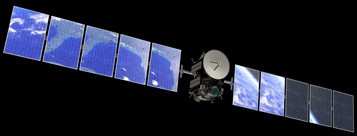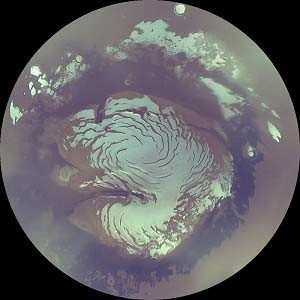Will Use Gravity Boost To Rendezvous With Asteroid
 With Valentine's Day approaching in the US Saturday, now's the
time when one's thoughts turn to matters of the heart... and it
appears NASA's Dawn spacecraft is "falling" hard for Mars. (OK,
it's a stretch, but bear with us here --
Ed.)
With Valentine's Day approaching in the US Saturday, now's the
time when one's thoughts turn to matters of the heart... and it
appears NASA's Dawn spacecraft is "falling" hard for Mars. (OK,
it's a stretch, but bear with us here --
Ed.)
Launched in September of 2007, and propelled by any one of a
trio of hyper-efficient ion engines, NASA's Dawn spacecraft passed
the orbit of Mars last summer. At that time, the asteroid belt had
never been closer. In early July the spacecraft began to lose
altitude, falling back towards the inner solar system. Then on
October 31, 2008, after 270 days of almost continuous thrusting,
the ion drive turned off.
"Not only are our thrusters off and we are dropping in altitude,
we are plunging toward Mars," said Marc Rayman, the Dawn project's
chief engineer from NASA's Jet Propulsion Laboratory in Pasadena,
CA. "And everybody here on Dawn could not be happier."
The team's joy at plummeting towards a planet named for the
Roman god of war is not unfounded. Mars, the final stop for many a
NASA spacecraft, was always an important, and weighty, waypoint for
the Dawn mission. It all has to do with one of the heavy subjects
of rocket science, gravity assists.
A gravity assist is the use of the relative movement and gravity
of a planet or other celestial body to alter the path and speed of
a spacecraft, typically in order to save fuel, time and expense. A
spacecraft traveling to an outer planet (or in this case asteroid)
will decelerate because the incessant tug of the sun's gravity
slows it down.
 By flying a spacecraft close by a large planet and its large
gravity field, some of the planet's speed as it orbits the sun is
transferred to the spacecraft. In Dawn's case, it is using the Red
Planet's tremendous angular momentum to give it a little extra
oomph.
By flying a spacecraft close by a large planet and its large
gravity field, some of the planet's speed as it orbits the sun is
transferred to the spacecraft. In Dawn's case, it is using the Red
Planet's tremendous angular momentum to give it a little extra
oomph.
"A big oomph actually," said Rayman. "The gravity of Mars will
change Dawn's path about the sun, enlarging its elliptical orbit
and sending the probe farther from the sun. It will also change
Dawn's orbital plane by more than 5 degrees. This is important
because Dawn has to maneuver into the same plane in which Vesta
orbits the sun."
If Dawn had to perform these orbital adjustments on its own with
no Mars gravitational deflection, it would have required the
spacecraft to fire up its engines and change velocity by more than
5,800 miles per hour (9,330 kilometers per second). Such velocity
changes would have required Dawn to carry an extra 230 pounds (104
kilograms) of xenon fuel.
"Without the gravity assist, our mission would not have been
affordable, even with the extraordinary capability of the ion
propulsion system," said Rayman. "That's why we are happy Dawn is
now plunging toward Mars."
Also happy for the opportunity to fly past the fourth rock from
the sun is Dawn's science team. With asteroid Vesta still more than
two-and-a-half years away, Mars provides the perfect opportunity to
give their highly-tuned instruments a workout.
"It is fortuitous that we need Mars to get out to Vesta and
Ceres," said Carol Raymond, Dawn's deputy principal investigator,
from JPL. "Since there are other spacecraft currently operating at
Mars with similar instrumentation, we will be able to check our
measurements against their knowledge of Mars, and carry that
information farther out into the solar system."
The Mars gravity assist is not the final hurdle on Dawn's road
to the asteroid belt. The subsequent 30 months include more than 27
months of blue-green tinged ion thrusting to successfully
rendezvous with Dawn's first target -- Vesta.
 Bolen Gives Congress a Rare Thumbs-Up
Bolen Gives Congress a Rare Thumbs-Up The SportPlane Resource Guide RETURNS!!!!
The SportPlane Resource Guide RETURNS!!!! Buying Sprees Continue: Textron eAviation Takes On Amazilia Aerospace
Buying Sprees Continue: Textron eAviation Takes On Amazilia Aerospace Hawker 4000 Bizjets Gain Nav System, Data Link STC
Hawker 4000 Bizjets Gain Nav System, Data Link STC Echodyne Gets BVLOS Waiver for AiRanger Aircraft
Echodyne Gets BVLOS Waiver for AiRanger Aircraft




